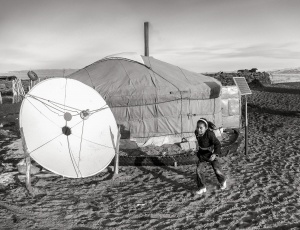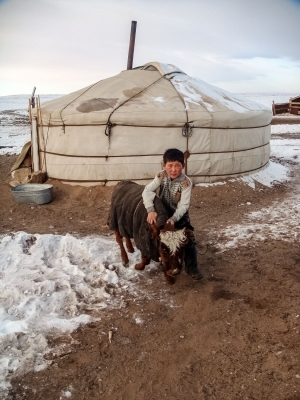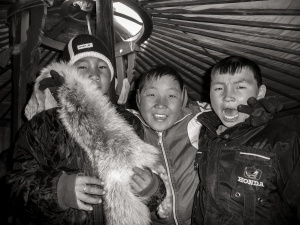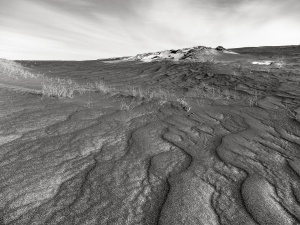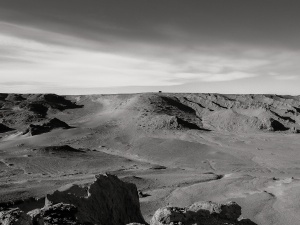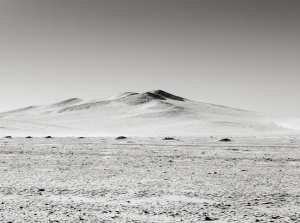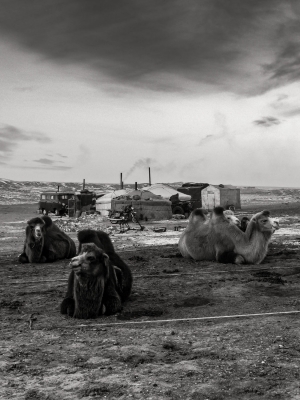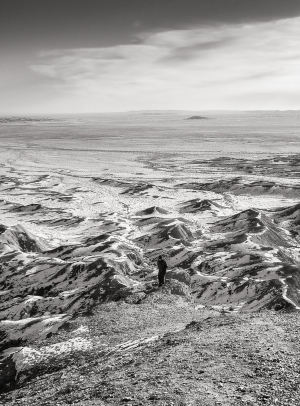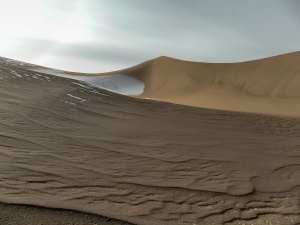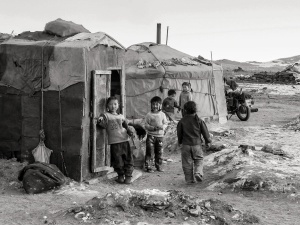Home > Outer Mongolia > The Gobi Desert
The Gobi Desert
At 800,000 km2, the Gobi Desert is the fourth-largest on Earth. This barren landscape stretches from Siberia to the Tibetan Plateau and is the largest desert in Asia. It's a harsh land of predominantly rocky terrain lying in the heart of Asia's most remote region.
Covering one-third of Mongolia the Gobi has an extreme climate. Temperatures range from +40° C in the summer to -40 in the winter. Receiving an average rainfall of less than 100 mm per year with some areas seeing it only once every two or three years.
Consequently, the severe environment prevents most forms of human habitation. The region is so cold and provides so little moisture to support human civilisation that the population density stays incredibly small. A single square kilometre is usually home to fewer than two people.
The Great Gobi Desert National Park
One of the world's largest Biospheres, the Great Gobi Desert National Park is larger than the Netherlands. This land of steppes, mountains, and sands is often regarded as a lifeless desert. In reality, however, most of the Gobi is rich in wildlife.
Vast open plains, immense spaces and an eerie silence. Any feeling of emptiness though is an illusion. The Gobi is home to the snow leopard, black-tailed gazelles, golden eagles, and the Gobi ibex. They co-exist with the wild ass, a small population of Gobi bears (the only desert-inhabiting bear) and the last remaining wild Bactrian (two-humped) camels.
Most of the Gobi consists of hard-packed rocky terrain and therefore relatively easy to traverse. Such topography enabled the Gobi to act historically as a viable trade route. Playing host to several important cities along the Silk Road, including Dunhuang. The Mogao Caves in Dunhuang is a UNESCO world heritage site.
Despite these trade routes, very minimal permanent settlement took place here until modern times. The majority of the population is Mongolian, but the number of Han Chinese in Inner Mongolia has been steadily increasing. Surprisingly, some of these Chinese residents hack out a living as farmers in some of the slightly more hospitable regions.
This recent influx of farmers is partially due to the speedy desertification of the surrounding area. Expanding into existing Chinese farmland, the Desert is growing year upon year.
The Nomads of the Gobi Desert
The Gobi is one of the few places on Earth that has been able to retain its culture and traditions throughout ancient history. Its landlocked position, harsh environment, and rocky geography have prevented any cultural changes over time.
Due to the extreme climate, residents remain close to animal herds, moving around for pasture and living a nomadic existence. For shelter, a circular dwelling called a 'ger' is quickly assembled and uniquely adapted to the conditions of the Gobi. This 'mobile home' offers respite from the sun during the day, whilst providing warmth when the temperatures drop significantly overnight. The design of this ger has changed very little in its 2000 plus year history.
Photographing the Gobi Desert
If you're anything like me and get a buzz from immense, captivating landscapes. Find a natural high in endless horizons and an almost complete lack of human habitation then its time to visit the Gobi Desert.
Needless to say, getting there will take time and patience. Boarding a plane and slipping into a slumber for a few hours isn't going to cut it.
Being a long way from recognisable society, the Gobi Desert is an uncomfortably long but comfortably breathtaking journey across some of the most sparsely populated regions on earth.
So pack your wide-angles, polarizers, arse cushions and SPF 50+ and be prepared for some major trigger-finger action.
Completely Useless Facts about the Gobi Desert
- The largest dinosaur fossil reservoir in the world can be found in the Gobi Desert
- It is growing at a rate of more than 21,000 km2 annually and its expansion into China is of serious concern. Consequently, a new forest is being planted around the Gobi. The 'Green Wall of China' project (implemented in 1978, with a target completion date of 2070) is an attempt to combat this desertification
- Though traditionally a nomadic people, residents of the Gobi offer a heartfelt welcome to all visitors. As an old Mongolian proverb concerning hospitality goes;
"Happy is the one who has guests, Merry is the home boasting a tethering rail full of visitors' horses."
Have a wemooch elsewhere...
Inspired?
Thinking about heading off into the wilds of the Gobi?
You'll need a few things to come together for it all to work out. There's some useful stuff to be clicked and pressed below.
